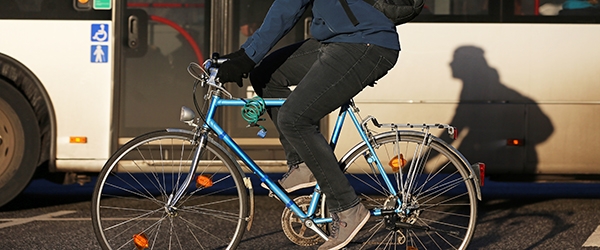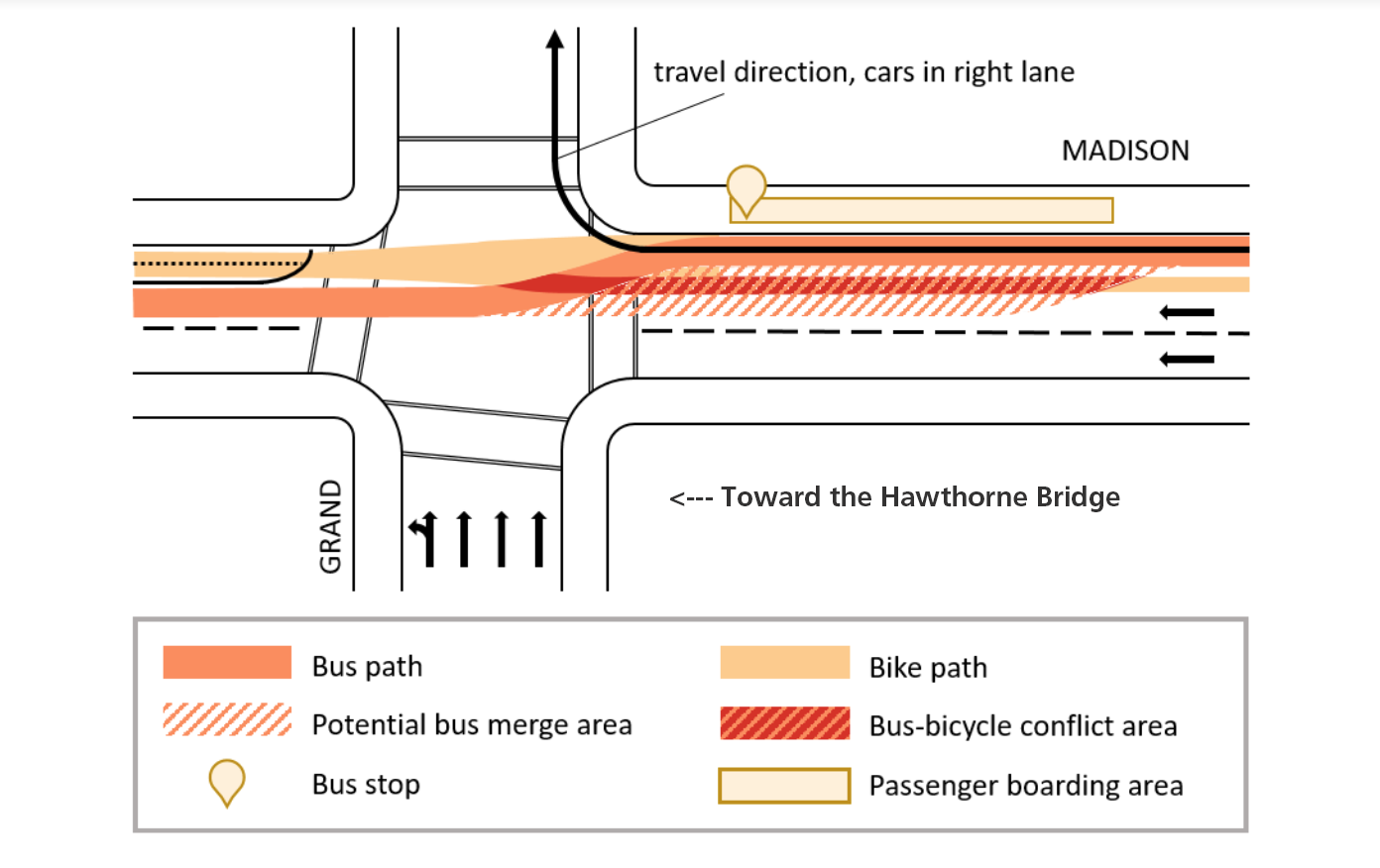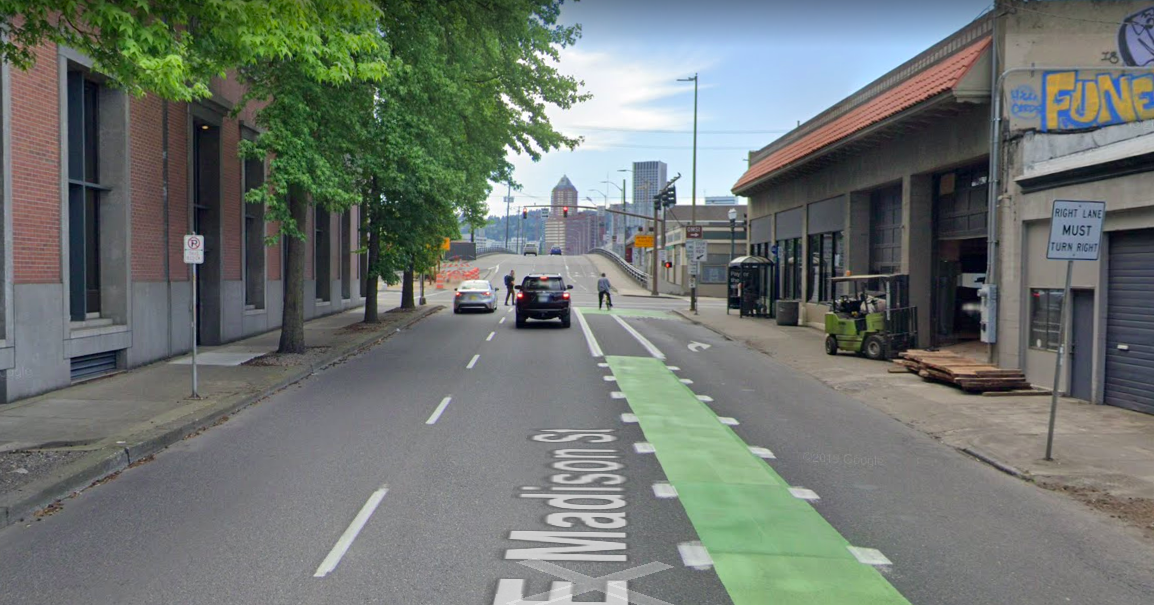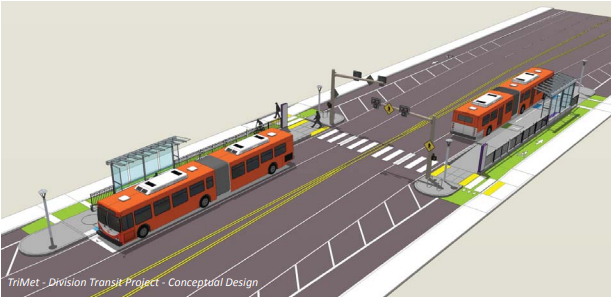Buses, Bikes, and Right-Turning Cars: Conflicts and Delays at the Transit Stop

- Download the Poster Presentation for “Evaluation of Bus-Bicycle and Bus/Right-Turn Traffic Delays and Conflicts” (PDF)
When buses and bikes share space, it's complicated. Not only are there safety risks for cyclists, but also potential delays in bus service and stressful navigation for bus operators. The quest to increase bus speeds—and plausibly, ridership—pushes transit agencies and cities to reduce bus delays.
Our latest report is the first study in the United States to look at bus, bicycle, and automobile interactions and conflicts (PDF). The lead researcher on the project is Miguel A. Figliozzi of Portland State University, with PSU students Katherine Keeling and Travis Glick. They observed interactions between buses, bikes and cars and analyzed two major concerns:
- The number of bus-bicycle conflicts (as a proxy for safety), and
- Bus delay as a result of these interactions.
STUDY SITE
Researchers observed 14 hours of video of buses serving the bus stop at the intersection at SE Madison St. and Grand Ave. in Portland, Oregon. Three bus routes (TriMet lines 2, 10, and 14) serve the morning commutes into downtown. This intersection is the closest to the westbound Hawthorne bridge access, Portland's most heavily cycled bridge, and data were collected in the summer when bicycle ridership is at its highest.


View of Madison St, facing west heading towards the Hawthorne bridge. A bicyclist waits in the bike box ahead at the signalized intersection with Grand Ave, a bus stop shelter to their right. Image source: Google Maps.
The intersection has a bike box to prevent vehicle encroachment on waiting bicycles. The area directly in front of the bus stop, but before the bike box, has a break in the bike lane's green pavement marking. This design graphically cues bicyclists that the uncolored section of the bicycle lane is not a bicycle-exclusive zone. This break in color prompts cyclists to pay attention, but it does not run the whole length of the potential conflict area.
BIKE-BUS INTERACTIONS AT THE STUDY SITE*
For every bus passing through the study site, the mixed-traffic scenario that the bus operators encountered was categorized as one of 72 different combinations of bus, bicycle, and automobile interactions. *Researchers spotted a few skateboarders, electric scooters or motorized board riders. If they were using the bicycle lane, they were counted as bicycles.
Scenarios with bicycles stopped in the bike box, bicycles stopped behind the bike box, bicycles that crossed the intersection before the bus, or the presence of right-turning vehicles were not found to cause any significant bus delay.
The only statistically significant variable related to traffic interactions was the number of bicycles behind the bus when crossing the intersection. Each bicycle crossing the intersection behind the bus, within 60 feet (a bus length and a half) of the bus, contributes 0.516 seconds of delay, according to the researchers' regression analysis. Scenarios with a bicycle behind the bus were ranked as more complex than bicycles in front of/overtaking the bus. The estimated annual number of high complexity conflicts is over 11,000. Watch a video example of a high-complexity traffic occurrence.
WHY THE HALF-SECOND DELAY?
When located within a distance of 60 feet, the presence of bicycle(s) forces a critical judgement call from the bus operator. The operator must judge the length of the gap and check to see whether the cyclist is yielding or intending to overtake the bus. When bus operators intend to merge away from the right lane, they are forced to make these assessments quickly, with the weight of their judgement directly bearing on a cyclist’s safety. These moments of assessment and calculation can accumulate into significant delays that impact bus travel time.
"The bus is merging away from the right lane and the bus operator has to make sure there is no car or bicycle in a blind spot. The bus operators are trained to be very 'conservative.' A crash, even a minor crash, has serious career consequences—unlike a normal car driver where minor crashes are not even reported," Figliozzi said.
The researchers interviewed a TriMet operator to get their opinion about the challenges presented in the study. The operator described the challenge of merging across a bicycle lane into a through-vehicle lane, "It’s hard to judge [a merge] when you have that much going on. Bicycles want to challenge buses and cars don’t want to let you in."
WHAT DOES THIS MEAN FOR INFRASTRUCTURE?
At current bus and bicycle volumes, over 11,000 annual conflicts can be expected. This volume of conflicts supports concern for cyclist safety. These quantitative findings can be used to justify funding for intersection upgrades or for an education/enforcement campaign.
It was found that the bike box onsite does not significantly contribute to bus delay, nor do bicycles that stop in the bicycle lane. Bike boxes have been studied with regards to their effects on cyclist and motorist comfort and perception of safety, and it is a welcome finding that they do not burden bus flow.
Researchers identified potential countermeasures to address bus-bike conflicts at the stop level.
BUS STOP ISLANDS

Configuring the bicycle lane to run behind the bus stop, as shown in this TriMet conceptual design, would eliminate all bus-bicycle conflicts. The Portland Bureau of Transportation has included these bus stop islands as an operational strategy in its Enhanced Transit Corridors Plan. Unfortunately, this configuration is best for wide roadways, as it requires a significant amount of right-of-way. Bicycles could potentially be redirected onto the sidewalk—which would increase bicyclists' comfort levels—but the study location only has a 10-foot sidewalk, so this would create new bicycle-pedestrian conflicts to replace the bus-bike conflicts. For any transit treatment, questions of costs and benefits rely on available data.
CONSOLIDATING STOPS
Another treatment option is relocating and consolidating bus stops so that there would no longer be a bus stop at a signalized intersection. Though there would still be bus-bicycle conflicts, this configuration would allow bus operators to focus on the merge without having to simultaneously navigate the traffic signal. However, the increased walking distance to reach a stop on Grand could have a negative effect on ridership; it would mean a longer walk to connect with the streetcar running on Grand Avenue. Read the report for more specifics on how this could impact the study site.
PAVEMENT MARKINGS
Another treatment option is to adjust the green paint in the bike lane, making a longer break in the green color to better align with the actual area of conflict. This may help cue cyclists to pay attention for conflicts earlier.
FUTURE RESEARCH CONSIDERATIONS
This study contributes to the U.S. Department of Transportation's nationwide goal of measuring the performance of transportation systems and supporting targeted investments to improve the experience of the traveling public. It should be noted that these results must be considered with caution due to the low number of observations. Future studies may solidify or reject these preliminary findings. Future research efforts should evaluate cost tradeoffs that result from the redesign of bus stop facilities at intersections with high volumes of conflicts and delays. Better design and engineering solutions can reduce conflicts and bus delays. In addition, education and/or enforcement strategies can be used to improve cyclist and driver awareness of bus priority and to improve transit operations citywide.
This research was funded by the National Institute for Transportation and Communities, with additional support from Portland State University and TriMet.
RELATED RESEARCH
To learn more about this and other (TREC) research, sign up for our monthly research newsletter.
- Modeling and Analyzing the Impact of Advanced Technologies on Livability and Multimodal Transportation Performance Measures in Arterial Corridors
- Using High-Resolution Bus Detection Data to Improve Travel Time Prediction and Identify Urban Congestion Spots
- Utilizing Ego-centric Video to Conduct Naturalistic Bicycling Studies
The Transportation Research and Education Center (TREC) at Portland State University is home to the National Institute for Transportation and Communities (NITC), the Initiative for Bicycle and Pedestrian Innovation (IBPI), and other transportation programs. TREC produces research and tools for transportation decision makers, develops K-12 curriculum to expand the diversity and capacity of the workforce, and engages students and professionals through education.
